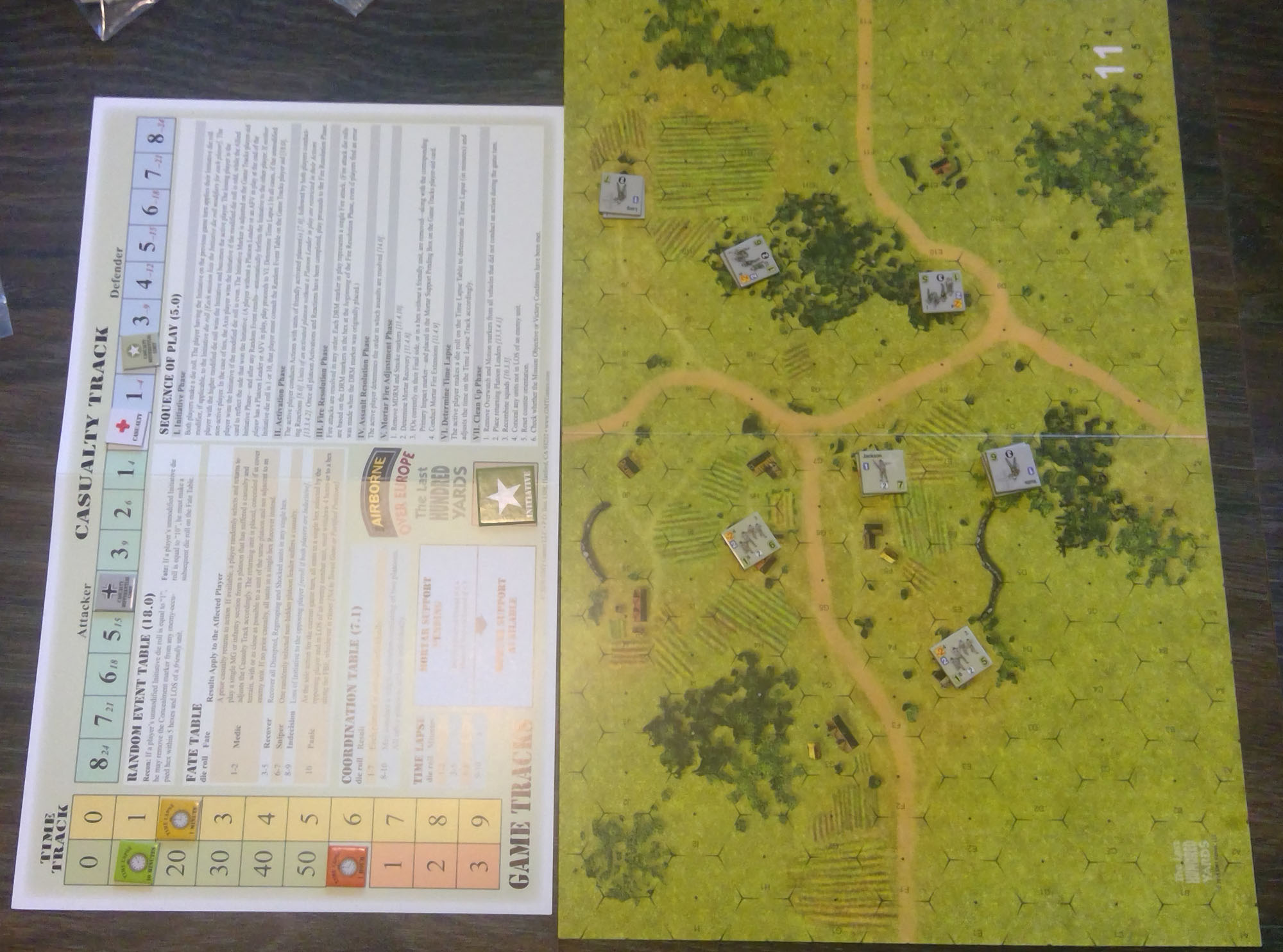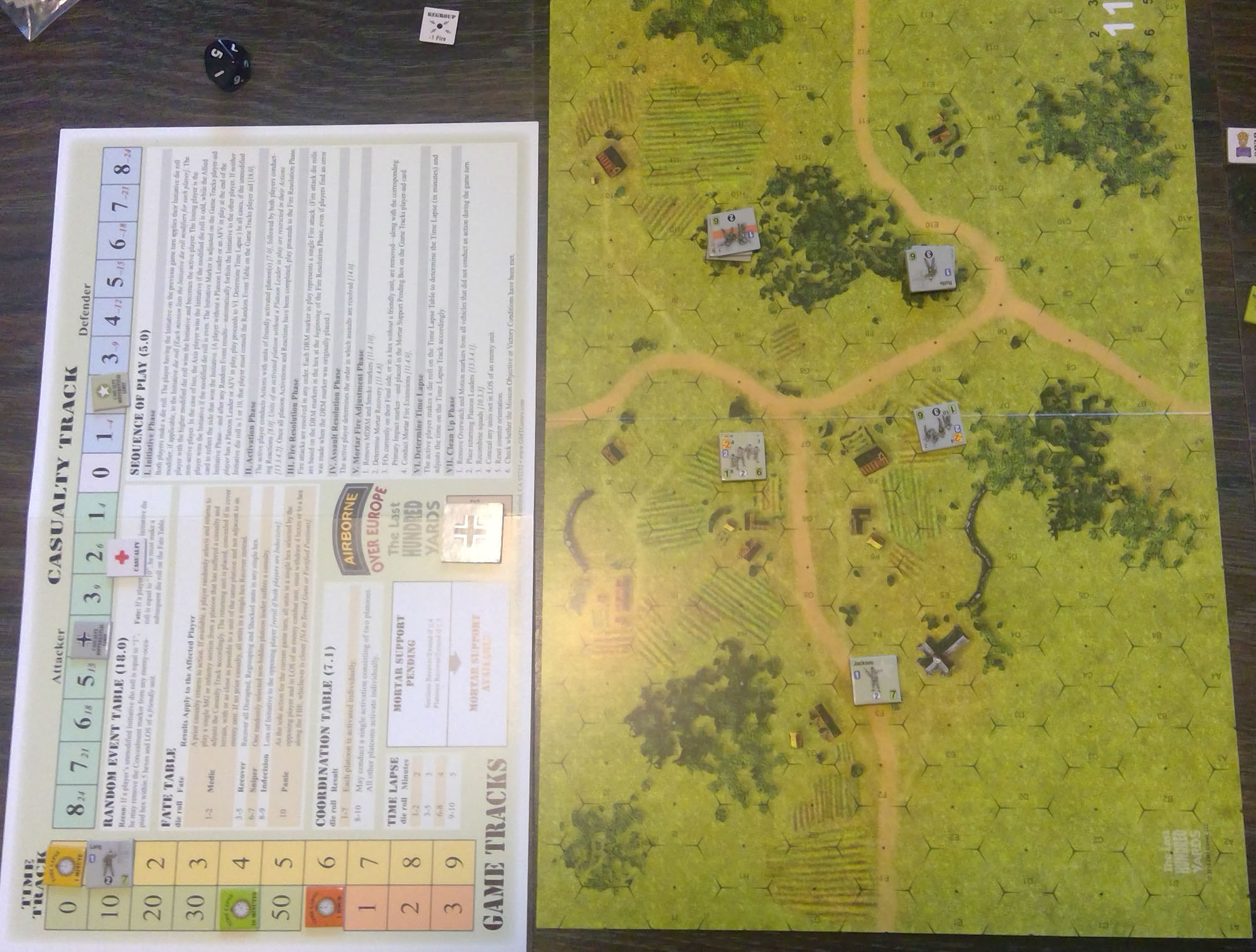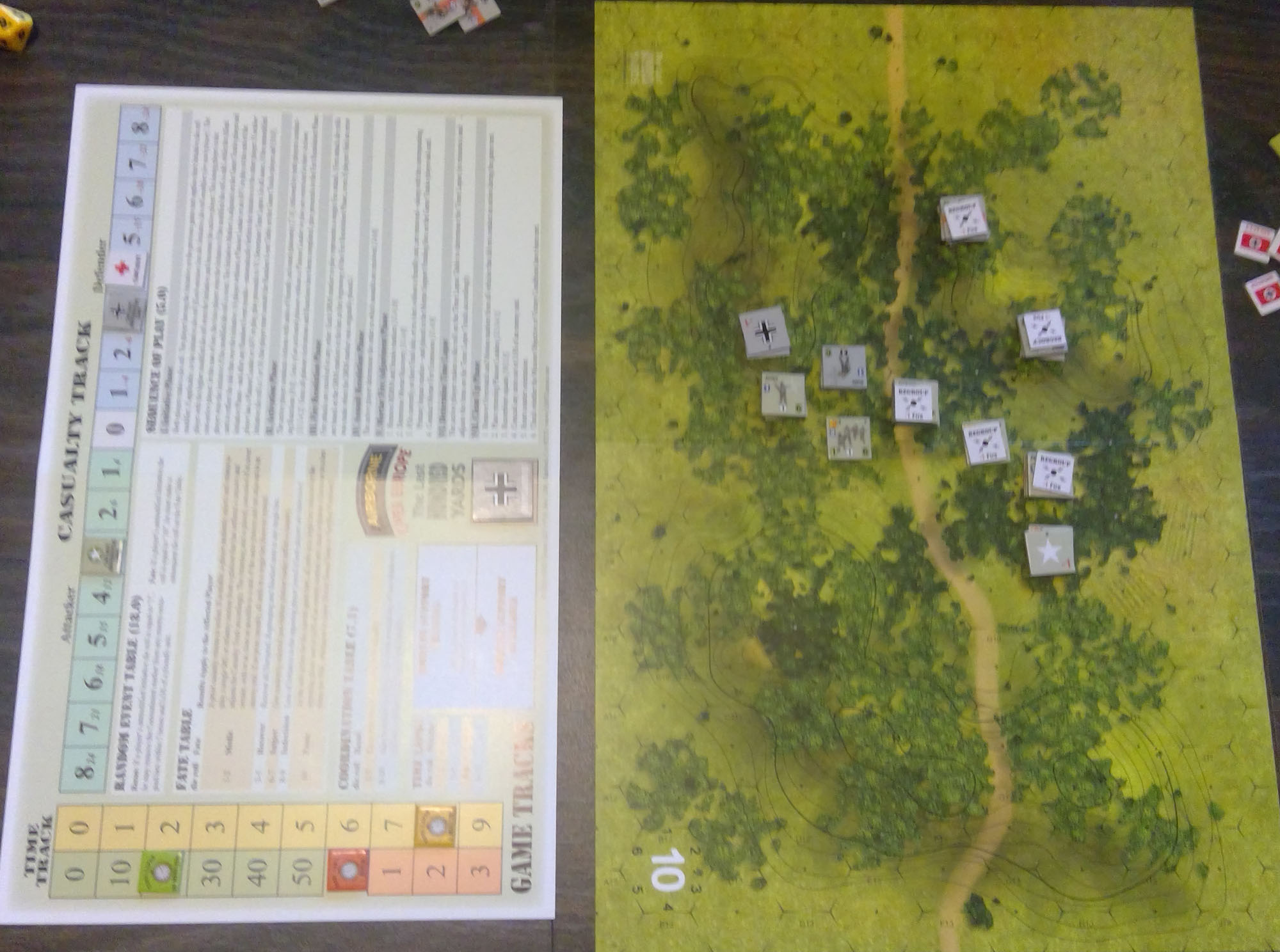The First Hundred Yards
Everyone here at my place has been vaccinated, and through the wait period for full effectiveness. So, face-to-face gaming is starting up again. On June 5th, Jason came over for the afternoon, and he introduced me to The Last Hundred Yards.
You can definitely see some influences from Squad Leader (yet another game with the same basic terrain modifiers on fire), but there’s plenty of places where its different as well. We ended up playing the first two scenarios, with me as the Americans both times. We also had a fair amount of ‘good to see you again’, and… a long show-and-tell session, as I’ve gotten a lot of stuff over the last year.
The first scenario has the Americans completely hidden at start with a single platoon (plus MG), while the Germans come in with a full company. I set up with the MG at the village crossroads, a squad plus platoon leader across the way, another squad overlooking the fields on one side, and the last in the trees on the other. That last kind of backfired, as Jason got pulled in on that flank to move to assault the squad, who withdrew towards the church (the primary, but not only, German goal), and he was on my flank in a hurry.

The MG should be revealed here, but I hadn’t spotted that he was within three hexes yet.
He got into my forward post (with the platoon leader) and drove them off with an assault. I managed to recover from that a little later, and reaction-assaulted a squad that got a bit further forward while he was assaulting my MG position (reaction put a squad in to help out. Both of them went well for me, but then a random event panicked my squads+leader back into withdrawing to the rear woods. Thankfully, Jason then had a platoon panic in turn, so that he couldn’t take advantage of the path to the church being open.
While Jason got reorganized, I started limited reactions back to the church… and then it was time. The scenario ends at 46 VP, with one VP to the defender per minute, and bonuses for causing more casualties than you take. After those assaults, Jason was behind by two (for 6 VP), and the clock hit 40, for 46 VP before Jason could take the buildings he needed.
The second scenario has you roll for initiative, and then either pick side or the end of the board you get. I got first pick, and took the end with the higher hill, and then Jason picked the Germans. It’s a meeting of patrols in Hurtgen, and the primary goal is to control more of a road through a woods board than the enemy, with the game ending after half an hour has passed.
This one was interesting, as with all the cover I wasn’t really sure how to approach the scenario. And it ended up being a good primer in close-quarters fighting. We ended up with a long series of back and forth assaults pushing back and forth in the woods. Since you can only have two squads active in an assault, the obvious thing became to use one squad to fire at the target, and then leap in with the other two. This was fairly even at first, but I got a couple good breaks after a bit, and I managed to push that to the point where Jason went over his casualty limit at the 28 minute mark (right before the normal end, which I would have won for road control).
Afterword
Overall, the flow of the game seems pretty good, and it’s generating some nice tense moments. Good job there.
A few nitpicks: The game has reduction of squads into remnant units, which are called ‘sections’. Since a section is usually a unit composed of a pair of squads, I’d prefer if ‘fire team’ or ‘half squad’ had been used. Color illustrations are popular on counters, but here, they’re similar colors and values to the background, so the art just dissolves into a blob when not looking closely. Nice bold line-art would have looked a lot better.
A bit bigger is the fact woods are inherent. The art makes this obvious (by going out to the edges of the hex), which is nice, but it’s true by rule too. This does make things a little simpler, but the use of terrain depictions for LOS has always been a strong point for SL/ASL and I’m surprised it isn’t used here. Also, fields show up on some of the maps… and have no purpose. Wading through a field of grain has a lot of atmosphere in ASL, and I’m surprised its not in here. It seems like different squad compositions (i.e., sub-machinegun squads) could be handled, but I’ve seen no sign of it yet. I’m definitely surprised American squads are rated at a lower effective range than German ones; I can only assume that this is from the inclusion of a machine gun in every German squad (and the BAR isn’t that long-ranged). The fact that German squads generally have higher cohesion (which is a bonus in assaults as well as elsewhere), while Americans have generally higher assault values is an interesting wrinkle.
Only being able to go three hexes at a time reduces ‘panzerbush’ syndrome to a minimum (at least for infantry), but the lack of reactions in the middle of movement does allow some of it to happen. I think a lot might be done by letting machine gun teams put down fire lanes, though that might need to preempt the action/reaction cycle, which would make things messy. However, the fact that you just put fire markers on target, and then resolve all fire after the action/reaction cycle is a very interesting idea, especially as you record the overall strength of that attack until it’s performed, and adds some nice uncertainty.
There seems to be a trend currently of operating units at one level above the basic maneuver units of a game as a group (LHY, Rifle & Spade, and GTS off the top of my head), and this is the strong point of the game. Working platoons as cohesive groups does a lot for the flow of the game, and does a lot to make its action-reaction cycle work. Thanks to a color-and-number labeling scheme, you can get up to a full battalion (of three companies), though ‘square’ formations are currently not in the game (the Americans and Germans don’t use them, I think the British were square at some levels though).
From what I’ve seen, the victory conditions of the scenarios are nicely varied. This can be a strong point with ASL scenarios (there’s some really inventive ones out there, though too often it gets down to the same-old), and it’s nice to see here. The variable time passing is neat… and I’d say it’s unnecessary (as turn is a turn is a turn), except that it does feed into many victory conditions and sets a variable ending point (kind of like Combat Commander/Great War Commander). Overall, I’ll be happy to try it again at some point.



Discussion ¬